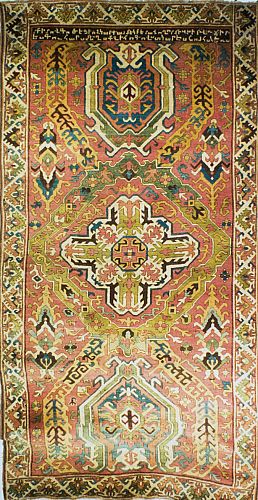
Back Армянскі дыван Byelorussian Армянскі дыван BE-X-OLD قالی ارمنی Persian Tapis arménien French Հայկական գորգ Armenian Հայկական գորգ HYW სომხური ხალიჩა Georgian Armeens tapijt Dutch Армянский ковёр Russian Armeniska mattor Swedish

The term Armenian carpet (Armenian: Հայկական գորգ; haykakan gorg) designates, but is not limited to, tufted rugs or knotted carpets woven in Armenia or by Armenians from pre-Christian times to the present.[1][2][3] It also includes a number of flat woven textiles. The term covers a large variety of types and sub-varieties. Due to their intrinsic fragility, almost nothing survives—neither carpets nor fragments—from antiquity until the late medieval period.
Traditionally, since ancient times the carpets were used in Armenia to cover floors, decorate interior walls, sofas, chairs, beds and tables.[4] Up to present the carpets often serve as entrance veils, decoration for church altars and vestry. Starting to develop in Armenia as a part of everyday life, carpet weaving was a must in every Armenian family, with the carpet making and rug making being almost women's occupation.[5] Armenian carpets are unique "texts" composed of the ornaments where sacred symbols reflect the beliefs and religious notions of the ancient ancestors of the Armenians that reached us from the depth of centuries. The Armenian carpet and rug weavers preserved strictly the traditions. The imitation and presentation of one and the same ornament-ideogram in the unlimited number of the variations of styles and colors contain the basis for the creation of any new Armenian carpet. In this relation, the characteristic trait of Armenian carpets is the triumph of the variability of ornaments that is increased by the wide gamut of natural colors and tints.
- ^ Temurjyan, В. С. (1955). "The Carpet Weaving in Armenia" ("Ковроделие в Армении"). Yerevan: Institute of History, Academy of Science of the Armenian SSR.
- ^ Davtyan Давтян С., С.; АН Армянской ССР (1975). "Armenian Carpet" ("Армянский карпет"). Yerevan: Academy of Science of the Armenian SSR.
- ^ Kouymjian, Dickran; Kévorkian et B. Achdjian (1991). "Les tapis à inscriptions arméniennes",in "Tapis et textiles arméniens". Marseilles. pp. 247–253.
{{cite book}}: CS1 maint: location missing publisher (link) - ^ N. Marr, Armgiz, 1939, Yerevan, p. 197 - in Russian
- ^ "Armenians. The End of the 19th - Beginning of the 20th century" at Russian Ethnographic Museum, St. Petersburg, Russia Archived December 24, 2009, at the Wayback Machine